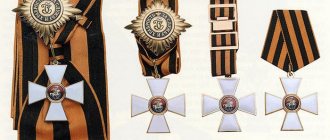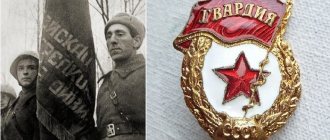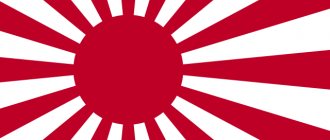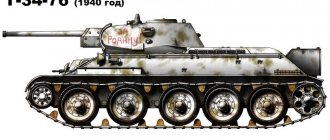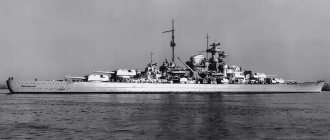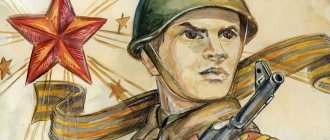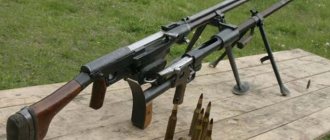The decision to highlight officers of the Russian army who showed particular courage on the battlefield came to Empress Catherine the Great in 1769. By her decree, the Order of St. George was established for these purposes, which she ordered to be attached to a silk ribbon of a special color: three black stripes separated by two yellow (orange). The combination of colors in the ribbon of the Order of Glory became symbolic for Russia, and was subsequently used for other insignia.
Symbolic meaning of color combination
There are several versions regarding the symbolism of the combination of black and yellow-orange colors and the empress’s choice of them as medal bearers. One of them says that the colors were state colors and meant a black double-headed eagle as a symbol of imperial power and a yellow field on which the coat of arms was placed. The second version refers to the holy great martyr in whose honor the award was named, St. George the Victorious, his martyrdom (black) and future resurrection (yellow). And finally, the third version is inclined to believe that these colors represent the symbolism of war, where yellow-orange represents flame, fire, and black represents gunpowder smoke. This version is supported by the fact that the award was intended as a badge of honor for those who distinguished themselves during military battles.
Modern symbolism of the Vologda coat of arms
A red heraldic shield with a right hand emerging from a silver cloud, which holds a golden sword and a silver orb - this is exactly the appearance of the modern coat of arms of Vologda, a photo of which can be seen in this article. What do all these symbols on the shield mean?
- Red color is a symbol of courage and strength.
- Gold - denotes wealth.
- Silver - nobility and light.
- The right hand is a symbol of right justice, protection.
- Power is a symbol of power and denotes the statehood of the city.
The ceremonial version of the coat of arms has the same symbols, but with additional traditional decorations. The shield is crowned with a golden tower crown with five teeth, which in turn branch into three teeth. The shield holders are young men in silver robes and with golden hair.
The young men are the prototypes of the Belorians who saved the city from enemies. They stand on a green hill. The young man standing on the right holds a raised silver sword with a golden hilt in his right hand. On the left stands the same young man with a raised sword in his left hand. The green hill is surrounded by the ribbon of the Order of the October Revolution. In 2003, the coat of arms was entered into the state register.
In 1997, it was decided to create a large and medium coat of arms of the city. The middle coat of arms is crowned with a golden tower crown and framed by spruce and pine branches (which indicates the natural features and riches of the northern region). The branches are intertwined with a ribbon in the color of the Russian flag.
First awards
The very first awards with the ribbon of St. George were awarded to participants in the Battle of Chesme in the Aegean Sea in the early summer of 1770. The glorious Russian squadron was commanded at that time by Count A. Orlov, under whose leadership a crushing blow was dealt to the Turkish fleet, which was significantly superior to the Russian fleet numbers. The count himself was among the first recipients of the award and received the honorary title “Chesmensky” to his surname.
Subsequently, various medals began to be celebrated with the St. George Ribbon, but always directly related to military operations. The first medals, decorated with a yellow-black insignia, found their heroes in August 1787 following the results of the battle that took place during the attempt to capture the Kinburn fortress by Turkish forces. The Russian soldiers were commanded by Suvorov, who had only a small detachment at his disposal. Despite this, the attack by a large group of Turkish soldiers was successfully repulsed. Suvorov himself received two wounds, but despite this, he remained in service until the victorious completion of the operation.
Previously, awards were given to all participants in outstanding battles, but this time, for the first time in Russian practice, only those who especially distinguished themselves during hostilities were awarded medals. Interestingly, the decision as to who showed outstanding personal bravery was left to the soldiers who participated in the campaign themselves. Among the named two dozen heroes was the grenadier Stepan Novikov, who distinguished himself by saving Suvorov from the hands of the Janissaries.
Victory March
No longer worn: civilian awards will be removed from military uniforms
Order “iconostasis” with medals of unknown origin are becoming a thing of the past
“Neither high breed, nor wounds received in front of the enemy, give the right to be awarded this order: but it is given to those who have not only corrected their position in everything according to their oath, honor and duty, but in addition have distinguished themselves by a special courageous act , or the wise gave useful advice for Our military service... This order should never be removed: for it is acquired by merit,” says the statute of the order, which was compiled by the president of the military board, Zakhar Chernyshev.
Soon after the first St. George's Day, a turning point occurred in the Russian-Turkish War. General Vasily Dolgorukov pressed back the enemy in the Crimea, Pyotr Rumyantsev established himself in the Danube steppes... Of course, this is not a matter of a new order. And yet, one cannot help but note: with George, the Russian army became truly victorious. And the first holder of the order was the modest Lieutenant Colonel Fyodor Fabritian, who with a small detachment defeated the superior forces of the Turks on the outskirts of the city of Galati. He was awarded the III degree of George.
The first (except for Catherine's symbolic self-award) cavalier of the highest degree was General-in-Chief Pyotr Aleksandrovich Rumyantsev. However, he received the field marshal's baton almost simultaneously with the order. After all, in one summer he defeated the Crimean and Turkish armies three times - at Ryaba Mogila, Larga and Kagul.
Photo: commons.wikimedia.org
General-in-Chief Pyotr Aleksandrovich Rumyantsev
“We carried out an examination of the Order of Victory awarded to Brezhnev”
Specialist of the Moscow Kremlin Museums Maria Sarycheva about the secrets of the main military award of the USSR
It was impossible to receive this order for parquet, and even more so for alcove successes. It had to be earned - and only with weapons in hand. Moreover, the first degree was awarded exclusively for victories that decided the fate of wars. More often - Russian commanders, but sometimes - allies, such as the Prussian Marshal Gebhard Blucher, who fought against Napoleon. For length of service, only the lowest IV degree could be awarded. For each degree of the order, lifetime monetary payments were awarded - for the first time in the history of our country.
Even Grigory Potemkin - Catherine’s all-powerful favorite, who for a long time retained the status of the second person in the empire - first, according to Rumyantsev, he deservedly received the III degree of “Egory”, then - II. And I - for the assault on Ochakov, when Prince Tauride had to show not only statesmanship, but also military leadership. And this victory became a turning point for the entire war: the Turks, having lost their outpost on the northern shore of the Black Sea, could no longer count on the return of Crimea...
The prestige of the award was impeccably maintained. Even with a strong desire, it is difficult to remember the unreasonable awarding of the Order of St. George, and especially its two highest degrees.
Collective awards
In order to be able to highlight entire military units, special insignia in the form of military trumpets were established in 1805. They were made of silver, bore the image of the St. George's Cross and were decorated with a ribbon of honorary colors. Under the cross there was an inscription about what exactly the team was awarded for. Pipes with the insignia were of two types - for cavalry (straight) and for infantry (which had a curved shape).
They were awarded as a special collective reward for military valor and the accomplishment of combat missions. A year later, St. George's Banners appeared to match them. They were topped with a white cross, under which was tied a St. George ribbon, decorated with banner tassels. Among the first standard bearers, the Chernigov Dragoon Regiment, the Kyiv Grenadiers, the Pavlograd Hussars, as well as two Cossack regimental units from the Don, distinguished themselves and were awarded.
How to fold a St. George's ribbon: diagram and MK step by step
The easiest way to model a ribbon is to fold it in a loop. Cut a piece of tape, 2.5 cm wide, length should be 25 cm.
make it a little beveled
carefully remove the template
St. George's ribbon in the form of a figure eight bow
Another stylish design option is in the form of a bow made of ribbons with four loops. Prepare 2 pieces 16 cm long, one 14 cm long and 1 piece 5 cm long.
Fold identical pieces of tape in half so that their opposite ends meet in the center. Place the folded ribbons side by side, right next to each other, and sew across them with large stitches.
For a piece 14 cm long, cut the ends in the shape of ticks and fold it in half.
Tighten the thread holding the long ribbons together well. Wrap the shortest piece of tape on top and secure. You now have a bow to which you should sew a tail.
We have told you two simple and fairly common methods; all that remains is to decide on which side the St. George’s ribbon will decorate your outfit during the holiday. A little hint - you should wear it closer to your heart.
Soldier's awards
By decree of Tsar Alexander I, soon after the introduction of collective insignia of valor, another special award was legalized, this time for lower military ranks. The “Insignia of the Military Order” was awarded to soldiers who showed personal heroism on the battlefield. The sign was in the shape of a cross, and it was prescribed to be worn on a ribbon, made in black and orange colors. It was this event that became the starting point for the nationwide recognition of the St. George Ribbon, because ordinary people see the awards of soldiers much more often than the decorations of officers. The name of the St. George's Cross became firmly established behind it. Among the common people, he was more often called soldier George or simply Yegor.
What colors are there?
In 1769, the ribbon had only three black and two orange stripes.
In Soviet awards during the Great Patriotic War and after it, there was a moire silk ribbon with longitudinal stripes of equal width - three black, two orange. And along the edges there was a narrow orange border.
In 1992, a Decree of the President of the Russian Federation was issued on the restoration of the St. George Cross as an award, and the ribbon, in terms of the location of the stripes and color combination, was supposed to return to the original version.
"For the defense of Sevastopol"
An award medal under this name was established by decree of the same year. This was the first time in the history of imperial Russia that such an award was presented not on the occasion of a heroic victory, but for services in the defense of a Russian city. The medal was cast in silver and awarded not only to the military, but also to civilians who showed personal heroism in defending the Russian city of Sevastopol. However, for the military, from general to soldier, this medal had a special difference - it was decorated with the St. George Ribbon.
The emergence of the ribbon in 2005
In 2005, ribbons were widely distributed for the first time - from that time on, a kind of “popularization” of ribbons began. The role of activists was played by the participants of the ROOSPPM “Student Community”, as well as concerned citizens from RIA Novosti. They handed out ribbons at large shopping centers, at metro stations, and simply tied ribbons to car antennas. Thus, the St. George ribbon became an indispensable attribute of meetings with veterans, holiday celebrations and other themed events. More than 800,000 ribbons were distributed that year, and the idea was well received not only by young people, but also by veterans.
Conclusion
Today this ribbon can be seen, as we already mentioned, on Victory Day or in a museum where ancient orders are presented. Treat the history of the people and their great victories with respect - the true value of the St. George ribbon is truly immeasurable, it will forever be preserved as one of the symbols of military bravery, courage and love for the fatherland.
Iconic awards
There were many regimental clergy in the Russian army, including those who showed special heroism during hostilities. This was a fairly common practice at the time. The reward also did not go unnoticed by the priests who showed bravery and courage. A special decree on this matter was issued in 1790. According to his instructions, the award was given to clergy who took personal heroic participation in military campaigns, and was a pectoral cross cast in gold and decorated with a St. George ribbon.
History has preserved their names. One of the first to receive the pectoral cross was Trofim Kutinsky, who served as a regimental priest in the battalion that stormed the Izmail fortress. After the death of the unit commander, the battalion fell into confusion. Father Trofim did not have a weapon, but he was the first to go against the enemy, taking a cross in his hands, and the soldiers followed him. The total number of awarded priests was 111 people, and each of them performed his own personal feat for the good of the Fatherland.
St. George's ribbon on medals of the USSR
There is a misconception that the time of the St. George's ribbon has sunk into oblivion along with the tsarist regime in 1917. There are numerous and sometimes very heated debates on this matter. However, one can only cite reliable facts.
Medal "For Victory"
The decree on its establishment was issued directly on the great Day of Victory and the signing of the surrender of Germany and had a block covered in the characteristic St. George colors. Awards were given to virtually all participants in the bloody war, including those who left the battlefield due to injury or other reasons (captivity, transfer to another job, etc.). The total number of recipients was almost 15 million.
Guards distinctions
The medal described above was not the first time the colors of the guards ribbon were used in the award insignia of the USSR. Since the autumn of the first war year, the title “Guards” was awarded as a special honorary distinction to military units and ship crews. In particular, the Soviet fleet had as a distinctive guards badge a plate covered with a characteristic ribbon, which naval officers wore on their jackets; sailors had such a badge on their caps. These differences were approved by Admiral Kuznetsov in June of the following year, 1942.
Throughout Russian military history, starting with the decree of the Great Empress, the country's award system used an extensive practice of military rewards, in which the St. George's colors were a symbol of special heroism, valor and military glory.
quote
The St. George ribbon was invented by journalists;
This is probably no coincidence - we feel the supernova of history and the status of civil society with our fingertips. Natalya Loseva, online newspaper “Vzglyad”
“There is nothing really massive in which, from a certain moment, the authorities do not participate in one way or another,” Alexander Privalov would write in Expert magazine two years later; This is a column in defense of the St. George's ribbon, that is, after two years it already needs protection. This is not the last case when the authorities notice a private initiative related to the memory of the war, and give it a national scale: the same will happen with the “Immortal Regiment”, invented by the Tomsk television. But with the ribbon, everything happens quickly, and immediately a “bending on the ground” arises: already in 2006, Mikhail Zygar wrote in the Kommersant-Vlast magazine that employees of the capital’s municipalities demanded that all retail establishments be decorated with ribbons: “So that there should be a ribbon on every counter and at every checkout!” Ribbons are handed out in slot machine halls, participants of the “Star Factory” perform on Channel One with a ribbon on their chests, newspapers write about the initiative of St. Petersburg climber and war veteran Mikhail Bobrov, who secured a ribbon at the very top of the spire of the Peter and Paul Fortress. In the spring of 2005, during the first season, ribbons were handed out by volunteers from the organization “Student Community”, then “pro-Kremlin youth” took over, introducing their characteristic gigantomania into the plot: in 2010, the “Young Guard of United Russia” will place a 30-meter St. George's ribbon at the entrance to Moscow on the Warsaw highway and will send the same one, only 50 meters long, to the still Ukrainian Sevastopol. A touching detail - a correspondent for the online publication “Vzglyad”, reporting about the ribbons of record length, also mentions the slogan that had just appeared: “The author of these lines, driving a few days ago along the M1 highway in the Smolensk area, personally saw on the back of one of the cars with a tied on the antenna with a ribbon, written with a finger in the dust, “Thank you to grandfather for the Victory.”
The ubiquity of the ribbon (and irritation - first with this ubiquity, and then with the ribbon itself) is only part of the changes taking place with the Victory Day: the military parade acquires a special scope (in 2007, Vladimir Putin and Dmitry Medvedev first appear on the podium with the St. George ribbon on jackets), holiday concerts with war songs performed by new pop stars are broadcast on TV, May 9 is becoming an important diplomatic factor - this is the day when world leaders, having forgotten their differences, can come to Moscow, and if someone ignored the holiday, that says something. In late Soviet times, May 9 was, first of all, a holiday “with tears in our eyes,” a day of remembrance for those who did not return from the war; now it is simply the most solemn day in the national calendar, the holiday is becoming more and more official and bravura, and the rituals accompanying it are in part completely ceremonial and media, and in others ridiculous and naive. Having risen to the state level, the ribbon turns from a unifying symbol into yet another cause for contention: a photograph of a bottle of vodka with a St. George ribbon tied to the neck, a poster for some house party with a half-naked girl in honor of Victory Day, irritation that the holiday has been vulgarized, that crazy amounts of money are spent on the parade, and veterans live in poverty, retaliatory irritation towards those who post bottles and are dissatisfied with the parade is now the same familiar attribute of May 9 for social networks as the broadcast of the parade is for television.
Columns for May 9 with titles like “Holiday of Lies and Hypocrisy” - now it’s impossible to imagine, but ten years ago it was a completely respectable genre - they were aimed at the official part of the holiday, but they ended up in the things most dear to readers, in the best that in the readers there is. Whatever the state does with this holiday, there is still a living memory inside it, it has not been interrupted or erased over time, and telling people that they express this memory is too tasteless, that they are fooled by propaganda, that they are trying to appropriate someone else’s feat for themselves, - not the best way to win their favor. Yes, the St. George ribbon is regularly tied in the wrong place, and front-line caps are unbecoming for children, but these excesses are a direct consequence of the fact that the new rituals have “gone in”, they were not just “imposed from above”, they have begun to live their own lives. There are many understandable reasons for this - patriotism, gratitude, memory.
